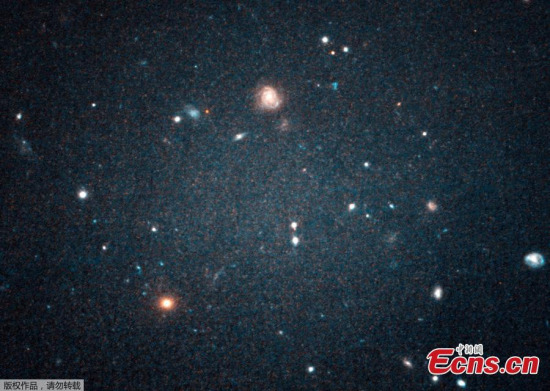
An image of galaxy NGC 1052-DF2 taken by the Hubble space telescope. (Photo/Agencies)
American astronomers have identified a galaxy that appears to have almost no dark matter, previously thought a foundation upon which galaxies are built.
In a study published on Wednesday in the journal Nature, scientists spotted a galaxy called NGC 1052-DF2, an ultra-diffuse galaxy so lacking in dark matter.
Since galaxies and dark matter typically go hand in hand, "this is a game changer," according to principal investigator Pieter van Dokkum of Yale University.
"For decades, we thought that galaxies start their lives as blobs of dark matter. After that everything else happens: gas falls into the dark matter halos, the gas turns into stars, they slowly build up, and then you end up with galaxies like the Milky Way. NGC 1052-DF2 challenges the standard ideas of how we think galaxies form," said van Dokkum.
Van Dokkum and his team used Keck telescopes in Hawaii and identified 10 globular clusters which are large compact groups of stars that orbit the galactic core.
According to the study, those globular clusters were moving much slower than expected. The slower the objects in a system move, the less mass there is in that system.
The team's calculations show that all of the mass in the galaxy could be attributed to the mass of the stars, which means there is almost no dark matter in NGC 1052-DF2.
"If there is any dark matter at all, it's very little," van Dokkum said. "The stars in the galaxy can account for all of the mass, and there doesn't seem to be any room for dark matter."
NGC 1052-DF2's globular clusters and atypical structure has perplexed astronomers aiming to determine the conditions this galaxy formed under.
NGC 1052-DF2 resides about 65 million light-years away in a collection of galaxies that is dominated by the giant elliptical galaxy NGC 1052.
Galaxy formation is turbulent and violent, and van Dokkum suggests that the growth of the fledgling massive galaxy billions of years ago perhaps played a role in NGC 1052-DF2's dark-matter deficiency.
Another idea is that a cataclysmic event within the oddball galaxy, such as the birth of myriad massive stars, swept out all the gas and dark matter, halting star formation.
These possibilities are speculative, however, and don't explain all of the characteristics of the observed galaxy.
"Every galaxy we knew about before has dark matter, and they all fall in familiar categories like spiral or elliptical galaxies," van Dokkum said. "But what would you get if there were no dark matter at all? Maybe this is what you would get."


















































